Petroleum System Modeling of a Fold and Thrust Belt: A Case Study from the Bannu Basin, Pakistan
Abstract
:1. Introduction
2. Study Area and Geological Setting
3. Petroleum System of Bannu Basin
4. Materials and Methods
5. Results and Discussions
5.1. Burial History
5.2. Basin Architecture
5.3. Heat Flow and Thermal History Modeling
5.4. Petroleum System Modeling
5.5. Controlling Factors for the Petroleum System of the Bannu Basin
6. Summary
7. Conclusions
- The burial history plot indicates the higher subsidence of the basin, mostly toward north. The subsurface modeling based on seismic interpretation indicates the presence of potential source, reservoir, seal and overburden rocks in the region.
- The thermal maturity of the basin indicates that the basal Mianwali Formation in the Southwestern zone and the Khisor Formation in the Southeastern zone enter into anearly gas window toward their deeper parts, whereas the upper source rocks enter into late oil to early oil windows in both zones. The deeper Chichali Formation of the Cretaceous age and the Panoba Formation of the Eocene age in the Northeastern zone mostly enter into main oil to early oil windows, respectively.
- The transformation ratio suggests that the Khisor Formation in the Southeastern and the Mianwali Formation in the Southeastern and Southwestern zones have been mostly transformed into hydrocarbons toward their deeper parts, whereas the kerogen in the Chichali Formation in the Southwestern and the Datta Formation in the Southeastern also partially transformed into hydrocarbons. In the northern zone, the transformation ratio is higher in the Chichali Formation when compared to Panoba Formation. Based on thermal maturity, it is assumed that all the source rocks have the potential to generate hydrocarbons.
- The migration pathways indicate a vertical trend which further moved upright toward the surface as a result of overburden rocks. In the Southwestern and Southeastern zones, the local faults act as barriers for hydrocarbon accumulation. In these zones, the Tredian, Lumshiwal, and Warcha Formations have good potential to act as reservoirs sealed by intraformational shales. However, in the Northeastern zone, the faults were not identified; as a result, no hydrocarbon accumulation is present in this study area.
- Lastly, the critical moments for peak hydrocarbon generation in all zones were in the Pliocene time as a result of post-Himalayan deposition from the north in the study area.
Author Contributions
Funding
Institutional Review Board Statement
Informed Consent Statement
Data Availability Statement
Acknowledgments
Conflicts of Interest
References
- Lampe, C.; Kornpihl, K.; Sciamanna, S.; Zapata, T.; Zamora, G.; Varadé, R. Petroleum systems modeling in tectonically complex areas—A 2D migration study from the Neuquen Basin, Argentina. J. Geochem. Explor. 2006, 89, 201–204. [Google Scholar] [CrossRef]
- Espitalié, J.; Ungerer, P.H.; Irwin, I.; Marquis, F. Primary cracking of kerogens. Experimenting and modelling C1, C2–C5, C6–C15 and C15+ classes of hydrocarbons formed. Org. Geochem. 1988, 13, 893–899. [Google Scholar] [CrossRef]
- Galushkin, Y.I.; Ushakov, S.A.; Zhizn, Z. Thermal regime and location of zones for hydrocarbon generation during basin evolution: Description of the methods and computer program. In Earth Life, Evolution of Earth and Planets; Moscow University Press: Moscow, Russia, 1990; pp. 102–108. [Google Scholar]
- Tissot, B.P.; Pelet, R.; Ungerer, P.H. Thermal history of sedimentary basins, maturation indices, and kinetics of oil and gas generation. AAPG Bull. 1987, 71, 1445–1466. [Google Scholar]
- Lopatin, N.V.; Galushkin, Y.I.; Makhous, M. Evolution of sedimentary basins and petroleum formation. In Geodynamic Evolution of Sedimentary Basins; Rouze, F., Ellouz, N., Shein, V.S., Skvortsov, I.I., Eds.; Editions Technip: Paris, France, 1996. [Google Scholar]
- Hu, D.; Rao, S.; Wang, Z.-T.; Hu, S.-B. Thermal and maturation history for Carboniferous source rocks in the Junggar Basin, Northwest China: Implications for hydrocarbon exploration. Pet. Sci. 2020, 17, 36–50. [Google Scholar] [CrossRef] [Green Version]
- Mashhadi, Z.S.; Rabbani, A.R.; Kamali, M.R.; Mirshahani, M.; Khajehzadeh, A. Burial and thermal maturity modeling of the Middle Cretaceous–Early Miocene petroleum system, Iranian sector of the Persian Gulf. Pet. Sci. 2015, 12, 367–390. [Google Scholar] [CrossRef] [Green Version]
- Zhang, J.; Guo, J.; Liu, J.; Shen, W.; Li, N.; Xu, G. 3D-basin modelling of the Lishui Sag: Research of hydrocarbon potential, petroleum generation and migration. Energies 2019, 12, 650. [Google Scholar] [CrossRef] [Green Version]
- Su, P.; Liang, J.; Qiu, H.; Xu, J.; Ma, F.; Li, T.; Wang, X.; Zhang, J.; Wan, Z.; Wang, F. Quantitative Simulation of Gas Hydrate Formation and Accumulation with 3D Petroleum System Modeling in the Shenhu Area, Northern South China Sea. Energies 2022, 16, 99. [Google Scholar]
- Iqbal, M.A.; Rezaee, R. Porosity and Water Saturation Estimation for Shale Reservoirs: An Example from Goldwyer Formation Shale, Canning Basin, Western Australia. Energies 2020, 13, 6294. [Google Scholar] [CrossRef]
- Wahid, A.; Salim, A.M.A.; Gaafar, G.R.; Yusoff, A.W.I.W. Tectonic development of the Northwest Bonaparte Basin, Australia by using Digital Elevation Model (DEM). In Proceedings of the IOP Conference Series: Earth and Environmental Science, Beijing, China, 7–8 July 2016; p. 012005. [Google Scholar]
- Casallas-Moreno, K.; González-Escobar, M.; Gómez-Arias, E.; Mastache-Román, E.; Gallegos-Castillo, C.; González-Fernández, A. Analysis of subsurface structures based on seismic and gravimetric exploration methods in the Las Tres Vírgenes volcanic complex and geothermal field, Baja California Sur, Mexico. Geothermics 2021, 92, 102026. [Google Scholar] [CrossRef]
- Baur, F.; Di Benedetto, M.; Fuchs, T.; Lampe, C.; Sciamanna, S. Integrating structural geology and petroleum systems modeling–A pilot project from Bolivia’s fold and thrust belt. Mar. Pet. Geol. 2009, 26, 573–579. [Google Scholar]
- Ungerer, P.; Burrus, J.; Doligez, B.; Chenet, P.Y.; Bessis, F. Basin evaluation by integrated two-dimensional modeling of heat transfer, fluid flow, hydrocarbon generation, and migration. AAPG Bull. 1990, 74, 309–335. [Google Scholar]
- Kutovaya, A.; Kroeger, K.F.; Seebeck, H.; Back, S.; Littke, R. Thermal effects of magmatism on surrounding sediments and petroleum systems in the northern offshore Taranaki Basin, New Zealand. Geosciences 2019, 9, 288. [Google Scholar] [CrossRef] [Green Version]
- Iqbal, M.A.; Salim, A.M.A.; Baioumy, H.; Gaafar, G.R.; Wahid, A. Identification and characterization of low resistivity low contrast zones in a clastic outcrop from Sarawak, Malaysia. J. Appl. Geophys. 2019, 160, 207–217. [Google Scholar] [CrossRef]
- Welte, D.H.; Tissot, P. Petroleum Formation and Occurrence; Springer: Berlin/Heidelberg, Germany, 1984. [Google Scholar]
- Emujakporue, G.O. Subsurface temperature distribution from heat flow conduction equation in part of chad sedimentary basin, Nigeria. Egypt. J. Pet. 2017, 26, 519–524. [Google Scholar] [CrossRef] [Green Version]
- Khalil Khan, H.; Ehsan, M.; Ali, A.; Amer, M.A.; Aziz, H.; Khan, A.; Bashir, Y.; Abu-Alam, T.; Abioui, M. Source rock geochemical assessment and estimation of TOC using well logs and geochemical data of Talhar Shale, Southern Indus Basin, Pakistan. Front. Earth Sci. 2022, 10, 1593. [Google Scholar] [CrossRef]
- Mani, D.; Patil, D.J.; Dayal, A.M.; Prasad, B.N. Thermal maturity, source rock potential and kinetics of hydrocarbon generation in Permian shales from the Damodar Valley basin, Eastern India. Mar. Pet. Geol. 2015, 66, 1056–1072. [Google Scholar] [CrossRef]
- Zhang, J.; Guo, J.; Li, Y.; Sun, Z. 3D-Basin Modeling of the Changling Depression, NE China: Exploring Petroleum Evolution in Deep Tight Sandstone Reservoirs. Energies 2019, 12, 1043. [Google Scholar] [CrossRef] [Green Version]
- Omodeo-Salé, S.; Ondrak, R.; Arribas, J.; Mas, R.; Guimerà, J.; Martínez, L. Petroleum systems modelling in a fold-and-thrust belt setting: The inverted cameros basin, north-central Spain. J. Pet. Geol. 2019, 42, 145–171. [Google Scholar] [CrossRef]
- Hadad, Y.T.; Hakimi, M.H.; Abdullah, W.H.; Makeen, Y.M. Thermal maturity history reconstruction and hydrocarbon generation/expulsion modeling of the syn-rift Rudeis and Kareem source rocks in the Red Sea Rift Basin, Sudan. Arab. J. Geosci. 2016, 9, 1–17. [Google Scholar] [CrossRef]
- Peters, K.E.; Curry, D.J.; Kacewicz, M. An overview of basin and petroleum system modeling: Definitions and concepts. In Basin Modeling: New Horizons in Research and Applications; AAPG Hedberg Series; Datapages, Inc.: Tulsa, OK, USA, 2012. [Google Scholar]
- Xiang, C.; Pang, X.; Yang, W.; Wang, J.; Li, Q.; Liu, L.; Li, Y. Hydrocarbon migration and accumulation along the fault intersection zone—A case study on the reef-flat systems of the No. 1 slope break zone in the Tazhong area, Tarim Basin. Pet. Sci. 2010, 7, 211–225. [Google Scholar] [CrossRef] [Green Version]
- Ahmad, N.; Khan, M.R. Evaluation of a distinct sub-play for enhanced exploration in an emerging petroleum province, Bannu-Kohat sub-basin, Pakistan. In Proceedings of the Oral Presentation at AAPG International Conference and Exhibition, Milan, Italy, 23–26 October 2011. [Google Scholar]
- Abir, I.A.; Khan, S.D.; Aziz, G.M.; Tariq, S. Bannu Basin, fold-and-thrust belt of northern Pakistan: Subsurface imaging and its implications for hydrocarbon exploration. Mar. Pet. Geol. 2017, 85, 242–258. [Google Scholar] [CrossRef]
- Khan, A.A. Bhittani Range, North Pakistan: The Tectonic Evolution and Hydrocarbon Prospectivity–a Geological and Geophysical Approach. Pak. J. Hydrocarb. Res. 2012, 22, 1–22. [Google Scholar]
- Zeb, S.F.; Zafar, M.; Jehandad, S.; Khan, T.; Siyar, S.M.; Qadir, A. Integrated geochemical study of Chichali Formation from Kohat sub-basin, Khyber Pakhtunkhwa, Pakistan. J. Pet. Explor. Prod. Technol. 2020, 10, 2737–2752. [Google Scholar] [CrossRef]
- Ali, A. Structural Analysis of the Trans-Indus Ranges: Implications for the Hydrocarbon Potential of the NW Himalayas, Pakistan. Ph.D. Thesis, Univeristy of Peshawar, Peshawar, Pakistan, 2010. [Google Scholar]
- Farid, A.; Khalid, P.; Ali, M.Y.; Iqbal, M.A.; Jadoon, K.Z. Seismic stratigraphy of the Mianwali and Bannu depressions, north-western Indus foreland basin. Int. J. Earth Sci. 2018, 107, 1557–1578. [Google Scholar] [CrossRef]
- Hemphill, W.R.; Kidwai, A.H. Stratigraphy of the Bannu and Dera Ismail Khan areas, Pakistan; USGS: Lakewood, CO, USA, 1973; pp. 2330–7102.
- Ishaq, K.; Wahid, S.; Yaseen, M.; Hanif, M.; Ali, S.; Ahmad, J.; Mehmood, M. Analysis of subsurface structural trend and stratigraphic architecture using 2D seismic data: A case study from Bannu Basin, Pakistan. J. Pet. Explor. Prod. 2021, 11, 1019–1036. [Google Scholar] [CrossRef]
- McDougall, J.W.; Khan, S.H. Strike-slip faulting in a foreland fold-thrust belt: The Kalabagh Fault and Western Salt Range, Pakistan. Tectonics 1990, 9, 1061–1075. [Google Scholar] [CrossRef]
- Sayab, M.; Khan, M.A.; Butt, K.A.; Pervaiz, K. Analyses of joints and associated neo-tectonic deformation band shear zones in the Siwalik Group of southern Surghar-Shingar Range, Trans-Indus Ranges, Pakistan. Geol. Bull. Univ. Peshawar 1999, 32, 25–39. [Google Scholar]
- Pivnik, D.A.; Khan, M.J. Transition from foreland-to piggyback-basin deposition, Plio-Pleistocene Upper Siwalik Group, Shinghar Range, NW Pakistan. Sedimentology 1996, 43, 631–646. [Google Scholar] [CrossRef]
- Kazmi, A.H.; Jan, M.Q. Geology and Tectonics of Pakistan; Graphic Publishers: Karachi, Pakistan, 1997. [Google Scholar]
- Qadri, H.A.; Wahid, A.; Siddiqui, N.A.; Ali, S.H.; El Aal, A.A.; Rashid, A.Q.B.A.; Temizi, M.N.B. Prospect Analysis of Paleocene Coalbed Methane: A Case Study of Hangu Formation, Trans-Indus Ranges, Pakistan. Geofluids 2022, 2022, 8313048. [Google Scholar] [CrossRef]
- Kazmi, A.H. Active fault systems in Pakistan. Geodyn. Pak. 1979, 12, 285. [Google Scholar]
- Mateen, A.; Wahid, A.; Janjuhah, H.T.; Mughal, M.S.; Ali, S.H.; Siddiqui, N.A.; Shafique, M.A.; Koumoutsakou, O.; Kontakiotis, G. Petrographic and geochemical analysis of Indus sediments: Implications for placer gold deposits, Peshawar Basin, NW Himalaya, Pakistan. Minerals 2022, 12, 1059. [Google Scholar] [CrossRef]
- Ghazi, S.; Ali, S.H.; Shahzad, T.; Ahmed, N.; Khalid, P.; Akram, S.; Ali, S.; Sami, J. Sedimentary, structural and salt tectonic evolution of Karoli-Nilawahan area, Central Salt Range and its impact for the Potwar Province. Himal. Geol. 2020, 41, 145–156. [Google Scholar]
- Ahmed, N.; Ali, S.H.; Ahmad, M.; Khalid, P.; Ahmad, B.; Akram, M.S.; Farooq, S.; Din, Z.U. Subsurface Structural Investigation Based on Seismic Data of the North-Eastern Potwar Basin, Pakistan. Indian J. Geo-Mar. Sci. 2022, 49, 1258–1268. [Google Scholar]
- Butler, R.W.H.; Coward, M.P.; Harwood, G.M.; Knipe, R.J. Salt control on thrust geometry, structural style and gravitational collapse along the Himalayan mountain front in the Salt Range of northern Pakistan. In Dynamical Geology of Salt and Related Structures; Elsevier: Amsterdam, The Netherlands, 1987; pp. 339–418. [Google Scholar]
- Lillie, R.J.; Johnson, G.D.; Yousuf, M.; Zamin, A.S.H.; Yeats, R.S. Structural Development within the Himalayan Foreland Fold-and-Thrust Belt of Pakistan; Datapages, Inc.: Tulsa, OK, USA, 1987. [Google Scholar]
- Blisniuk, P.M.; Sonder, L.J.; Lillie, R.J. Foreland normal fault control on northwest Himalayan thrust front development. Tectonics 1998, 17, 766–779. [Google Scholar] [CrossRef]
- Wahid, A.; Rauf, A.; Ali, S.H.; Khan, J.; Iqbal, M.A.; Haseeb, A. Impact of complex tectonics on the development of geo-pressured zones: A case study from petroliferous Sub-Himalayan Basin, Pakistan. Geopersia 2022, 12, 89–106. [Google Scholar]
- Kazmi, A.H.; Rana, R.A. Tectonic Map of Pakistan, Geological Survey of Pakistan; Graphic Publishers: Karachi, Pakistan, 1982. [Google Scholar]
- Ali, S.H.; Shoukat, N.; Bashir, Y.; Qadri, S.M.T.; Wahid, A.; Iqbal, M.A. Industrial Research Lithofacies and Sedimentology of Baghanwala Formation (Early-Middle Cambrian), Eastern Salt Range, Pakistan. Pak. J. Sci. Ind. Res. 2021, 65, 159–168. [Google Scholar]
- Yasin, Q.; Baklouti, S.; Khalid, P.; Ali, S.H.; Boateng, C.D.; Du, Q. Evaluation of shale gas reservoirs in complex structural enclosures: A case study from Patala Formation in the Kohat-Potwar Plateau, Pakistan. J. Pet. Sci. Eng. 2021, 198, 108225. [Google Scholar] [CrossRef]
- Ghazi, S.; Ali, S.H.; Sahraeyan, M.; Hanif, T. An overview of tectonosedimentary framework of the Salt Range, northwestern Himalayan fold and thrust belt, Pakistan. Arab. J. Geosci. 2015, 8, 1635–1651. [Google Scholar] [CrossRef]
- Alam, I.; Azhar, A.M.; Khan, M.W. Frontal structural style of the Khisor Range, northwest of Bilot: Implications for hydrocarbon potential of the north-western Punjab fore deep, Pakistan. J. Himal. Earth Sci. 2014, 47, 87–98. [Google Scholar]
- Javed, A.; Wahid, A.; Mughal, M.S.; Khan, M.S.; Qammar, R.S.; Ali, S.H.; Siddiqui, N.A.; Iqbal, M.A. Geological and petrographic investigations of the Miocene Molasse deposits in sub-Himalayas, district Sudhnati, Pakistan. Arab. J. Geosci. 2021, 14, 1–24. [Google Scholar] [CrossRef]
- Khan, M.A.; Ahmed, R.; Raza, H.A.; Kemal, A. Geology of petroleum in Kohat-Potwar depression, Pakistan. AAPG Bull. 1986, 70, 396–414. [Google Scholar]
- Wandrey, C.J.; Law, B.E.; Shah, H.A. Patala-Nammal Composite Total Petroleum System, Kohat-Potwar Geologic Province, Pakistan; US Department of the Interior, US Geological Survey Reston: Lakewood, CO, USA, 2004.
- Quad Consulting Limited. Geological and Geophysical Evaluation of Block-35 and Adjacent Areas, Northern Pakistan for Pakistan Petroleum Limited. J. King Saud Univ. Sci. 1996, 33, 101235. [Google Scholar]
- Khan, M.Z.; Khan, M.R.; Raza, A. Reservoir Potential of Marwat and Khisor Trans Indus Ranges, Northwest Pakistan. In Proceedings of the AAPG, Istanbul, Turkey, 14–17 September 2014. [Google Scholar]
- Wahid, A.; Salim, A.M.A.; Gaafar, G.R.; Yusoff, W.I.W. The geostatistical approach for structural and stratigraphic framework analysis of offshore NW Bonaparte Basin, Australia. In AIP Conference Proceedings; AIP Publishing: Melville, NY, USA, 2016; p. 020030. [Google Scholar]
- Janjua, O.A.; Wahid, A.; Salim, A.M.A.; Rahman, M.N.B.A. Prospect evaluation of shallow I-35 reservoir of NE Malay Basin offshore, Terengganu, Malaysia. In AIP Conference Proceedings; AIP Publishing: Melville, NY, USA, 2016; p. 020019. [Google Scholar]
- Hantschel, T.; Kauerauf, A.I. Fundamentals of Basin and Petroleum Systems Modeling; Springer: Berlin/Heidelberg, Germany, 2009. [Google Scholar]
- Wygrala, B.P. Integrated Study of an Oil Field in the Southern Po Basin, Northern Italy; Kernforschungsanlage Jülich GmbH, Zentralbiliothek, Verlag: Jülich, Germany, 1989. [Google Scholar]
- Gallagher, K.; Sambridge, M. The resolution of past heat flow in sedimentary basins from non-linear inversion of geochemical data: The smoothest model approach, with synthetic examples. Geophys. J. Int. 1992, 109, 78–95. [Google Scholar] [CrossRef] [Green Version]
- Shah, S.B.A.; Abdullah, W.H. Structural interpretation and hydrocarbon potential of Balkassar oil field, eastern Potwar, Pakistan, using seismic 2D data and petrophysical analysis. J. Geol. Soc. India 2017, 90, 323–328. [Google Scholar] [CrossRef]
- Bassam, A.; Santoyo, E.; Andaverde, J.; Hernández, J.; Espinoza-Ojeda, O.J.C. Estimation of static formation temperatures in geothermal wells by using an artificial neural network approach. Comput. Geosci. 2010, 36, 1191–1199. [Google Scholar] [CrossRef]
- Sweeney, J.J.; Burnham, A.K. Evaluation of a simple model of vitrinite reflectance based on chemical kinetics. AAPG Bull. 1990, 74, 1559–1570. [Google Scholar]
- Hakimi, M.H.; Abdulah, W.H.; Shalaby, M.R. Organic geochemistry, burial history and hydrocarbon generation modelling of the Upper Jurassic Madbi Formation, Masila Basin, Yemen. J. Pet. Geol. 2010, 33, 299–318. [Google Scholar] [CrossRef]
- He, S.; Middleton, M. Heat flow and thermal maturity modelling in the northern Carnarvon Basin, North West Shelf, Australia. Mar. Pet. Geol. 2002, 19, 1073–1088. [Google Scholar] [CrossRef]
- Li, M.; Wang, T.; Chen, J.; He, F.; Yun, L.; Akbar, S.; Zhang, W. Paleo-heat flow evolution of the Tabei Uplift in Tarim Basin, northwest China. J. Asian Earth Sci. 2010, 37, 52–66. [Google Scholar] [CrossRef]
- Poelchau, H.S.; Baker, D.R.; Hantschel, T.; Horsfield, B.; Wygrala, B. Basin simulation and the design of the conceptual basin model. In Petroleum and Basin Evolution; Springer: Berlin/Heidelberg, Germany, 1997; pp. 3–70. [Google Scholar]
- Shalaby, M.R.; Hakimi, M.H.; Abdullah, W.H. Geochemical characteristics and hydrocarbon generation modeling of the Jurassic source rocks in the Shoushan Basin, north Western Desert, Egypt. Mar. Pet. Geol. 2011, 28, 1611–1624. [Google Scholar] [CrossRef]
- Shalaby, M.R.; Hakimi, M.H.; Abdullah, W.H. Modeling of gas generation from the Alam El-Bueib formation in the Shoushan Basin, northern Western Desert of Egypt. Int. J. Earth Sci. 2013, 102, 319–332. [Google Scholar] [CrossRef]
- Welte, D.; Yukler, M. Petroleum origin and accumulation in basin evolution—A quantitative model. AAPG Bull. 1981, 65, 1387–1396. [Google Scholar]
- Welte, D.H.; Yalcin, M.N. Basin modelling—A new comprehensive method in petroleum geology. In Organic Geochemistry in Petroleum Exploration; Elsevier: Amsterdam, The Netherlands, 1988; pp. 141–151. [Google Scholar]
- Moody, J.D. Petroleum exploration aspects of wrench-fault tectonics. AAPG Bull. 1973, 57, 449–476. [Google Scholar]
- Chapple, W.M. Mechanics of thin-skinned fold-and-thrust belts. Geol. Soc. Am. Bull. 1978, 89, 1189–1198. [Google Scholar] [CrossRef]
- Davis, D.M.; Engelder, T. The role of salt in fold-and-thrust belts. Tectonophysics 1985, 119, 67–88. [Google Scholar] [CrossRef]
- Parvez, M.K. Petroleum Geology of Kohat-Bannu Plateau, Northwest Frontier Province, Pakistan; University of South Carolina: Columbia, SC, US, 1992. [Google Scholar]
- Sercombe, W.J.; Pivnik, D.A.; Wilson, W.P.; Albertin, M.L.; Beck, R.A.; Stratton, M.A. Wrench faulting in the northern Pakistan foreland. AAPG Bull. 1998, 82, 2003–2030. [Google Scholar] [CrossRef]
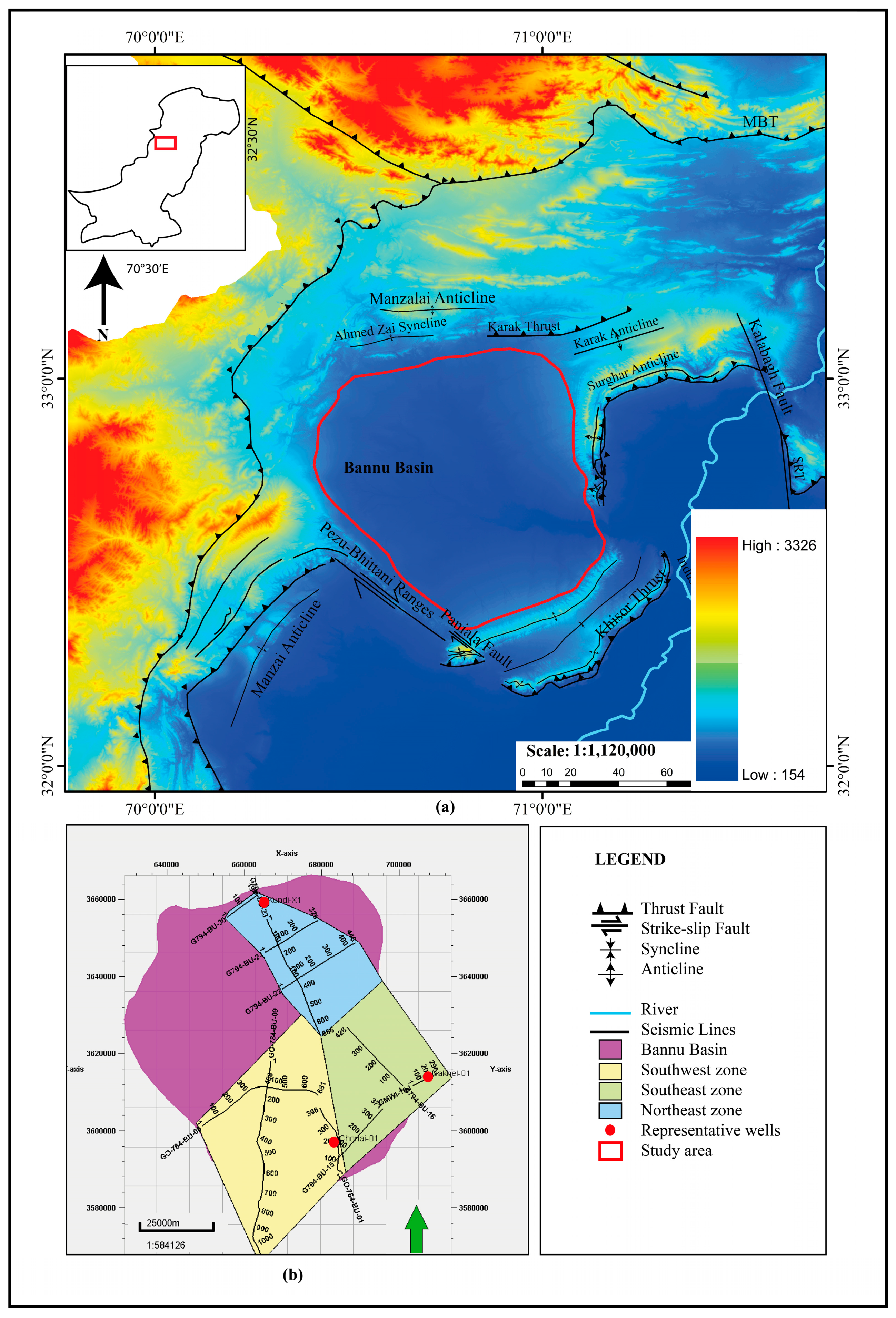
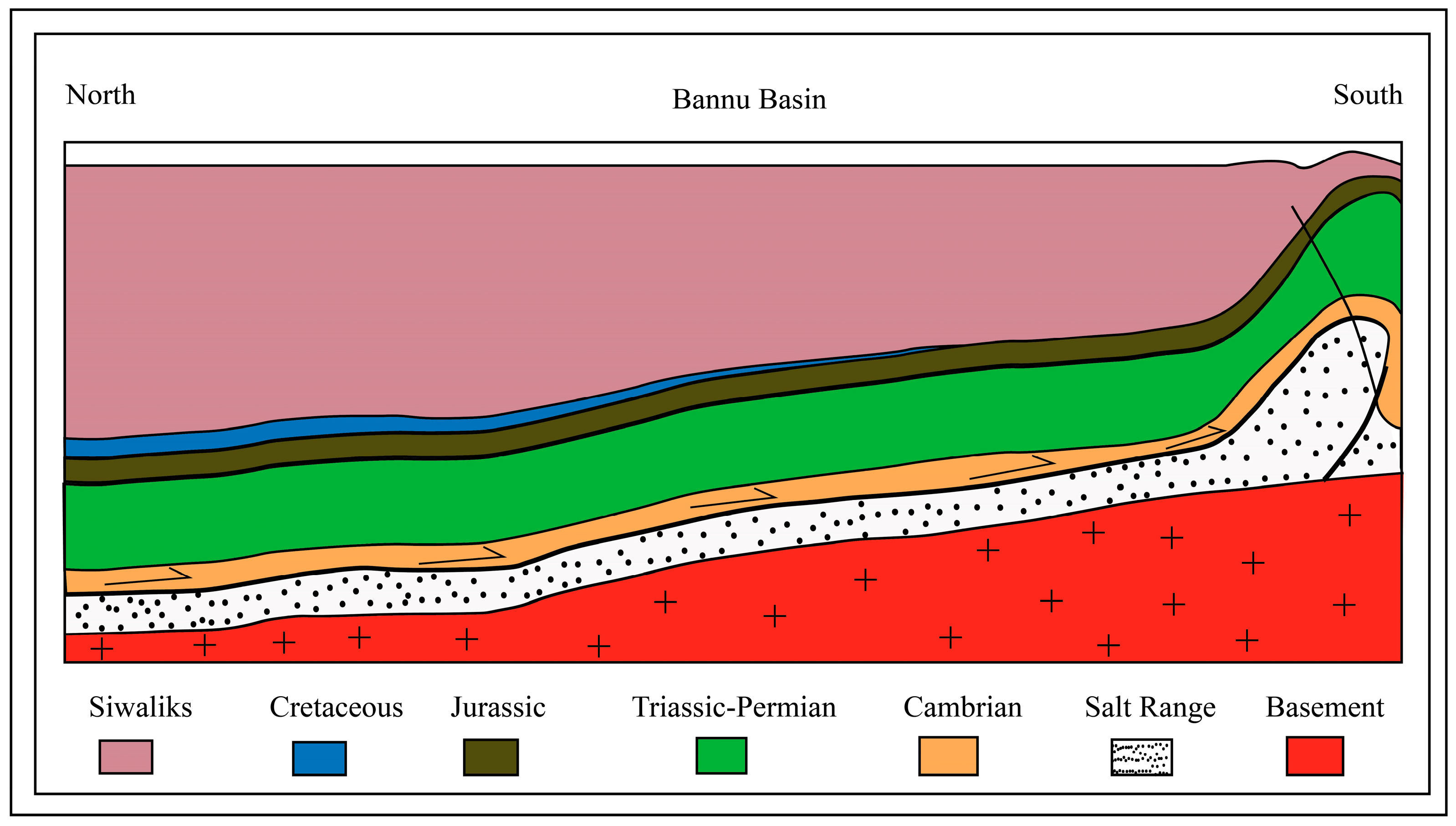
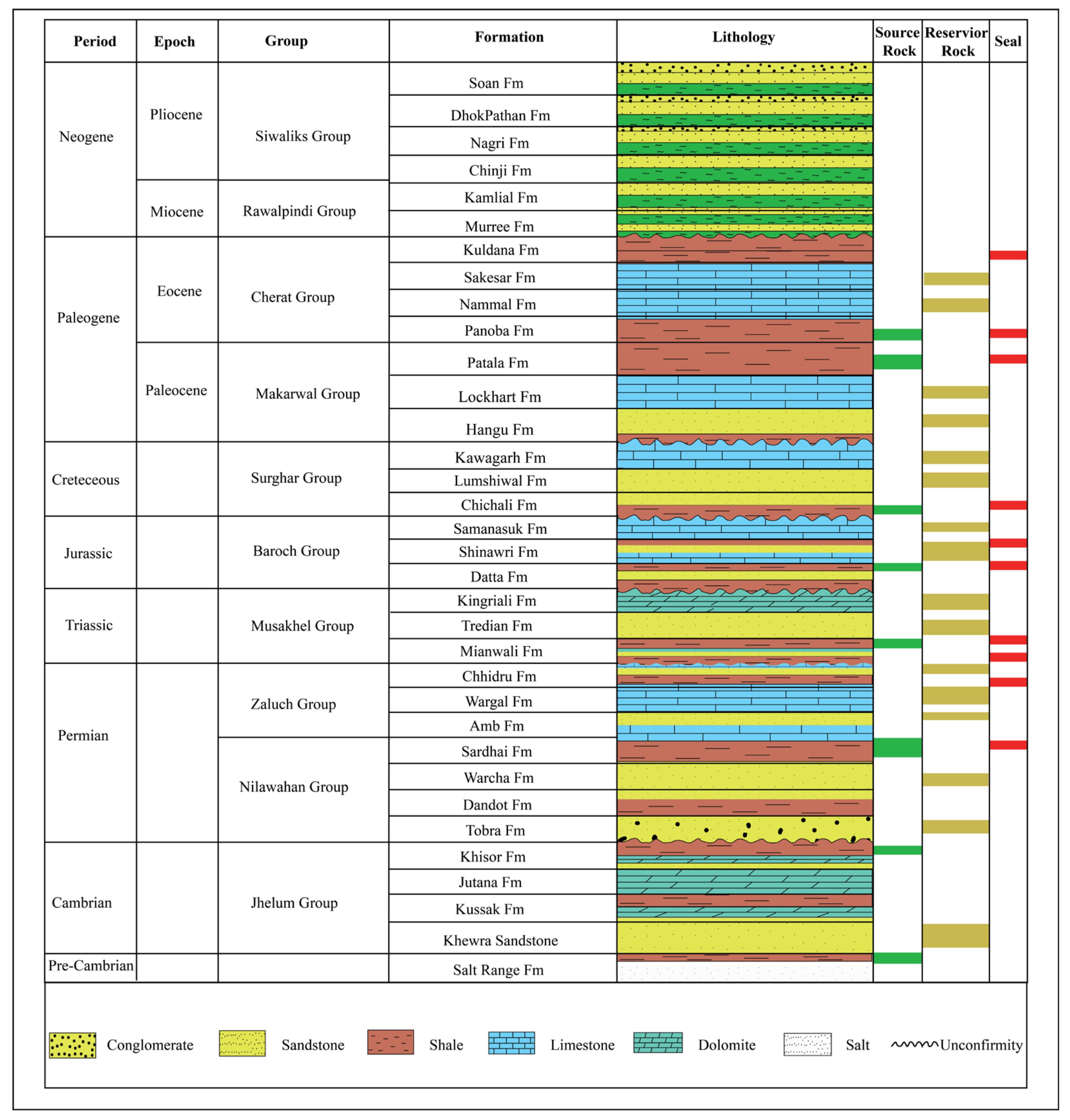
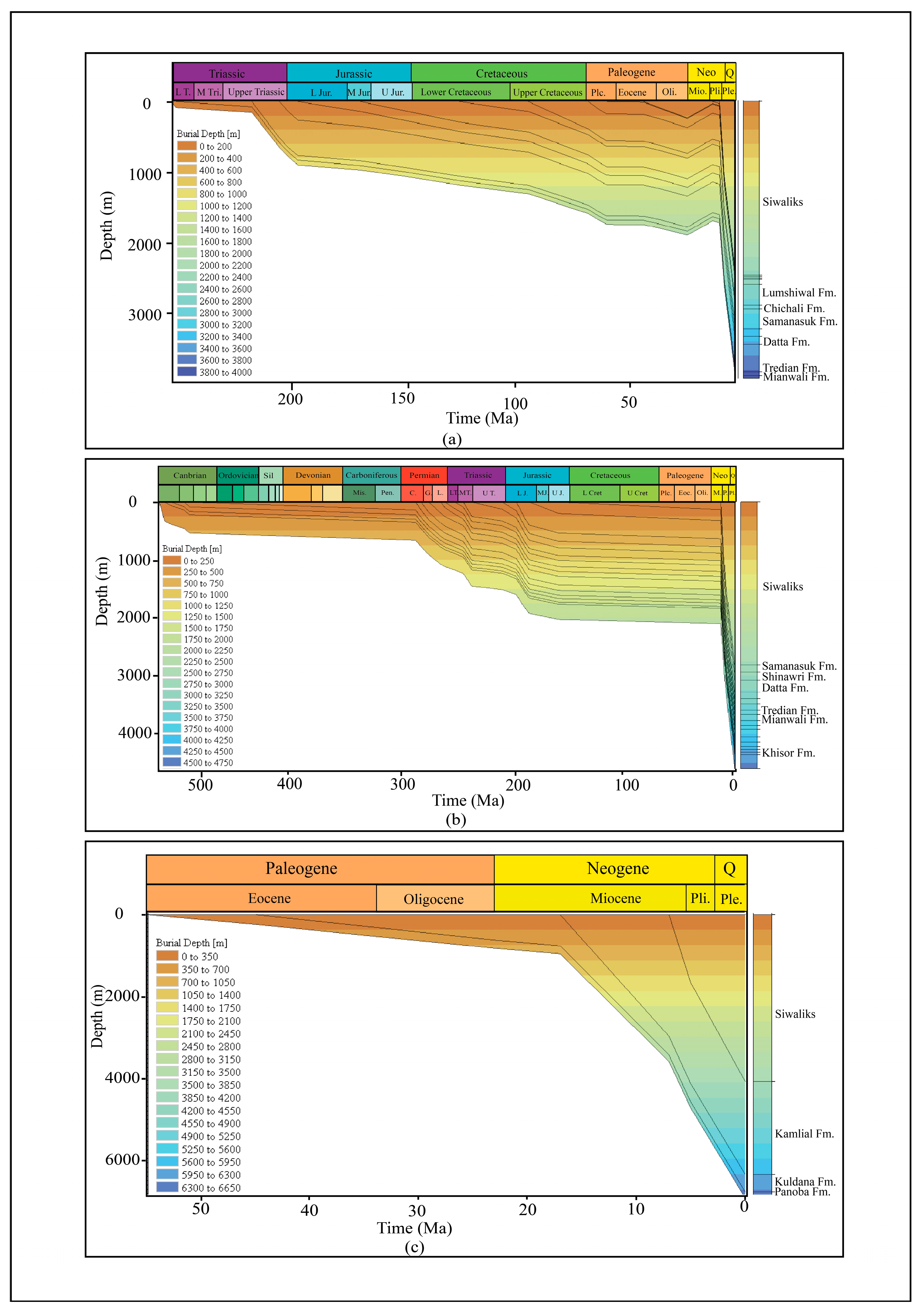

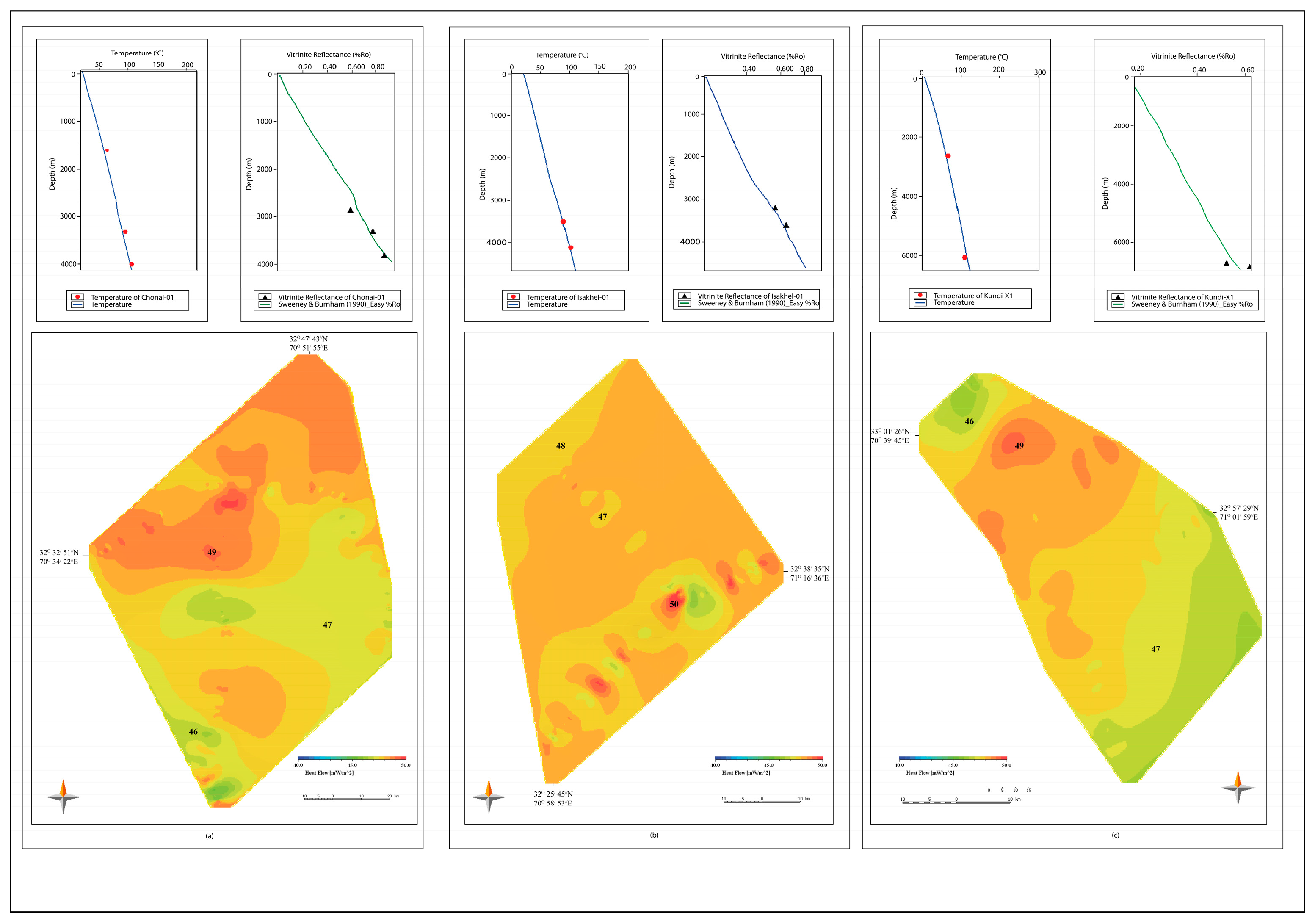
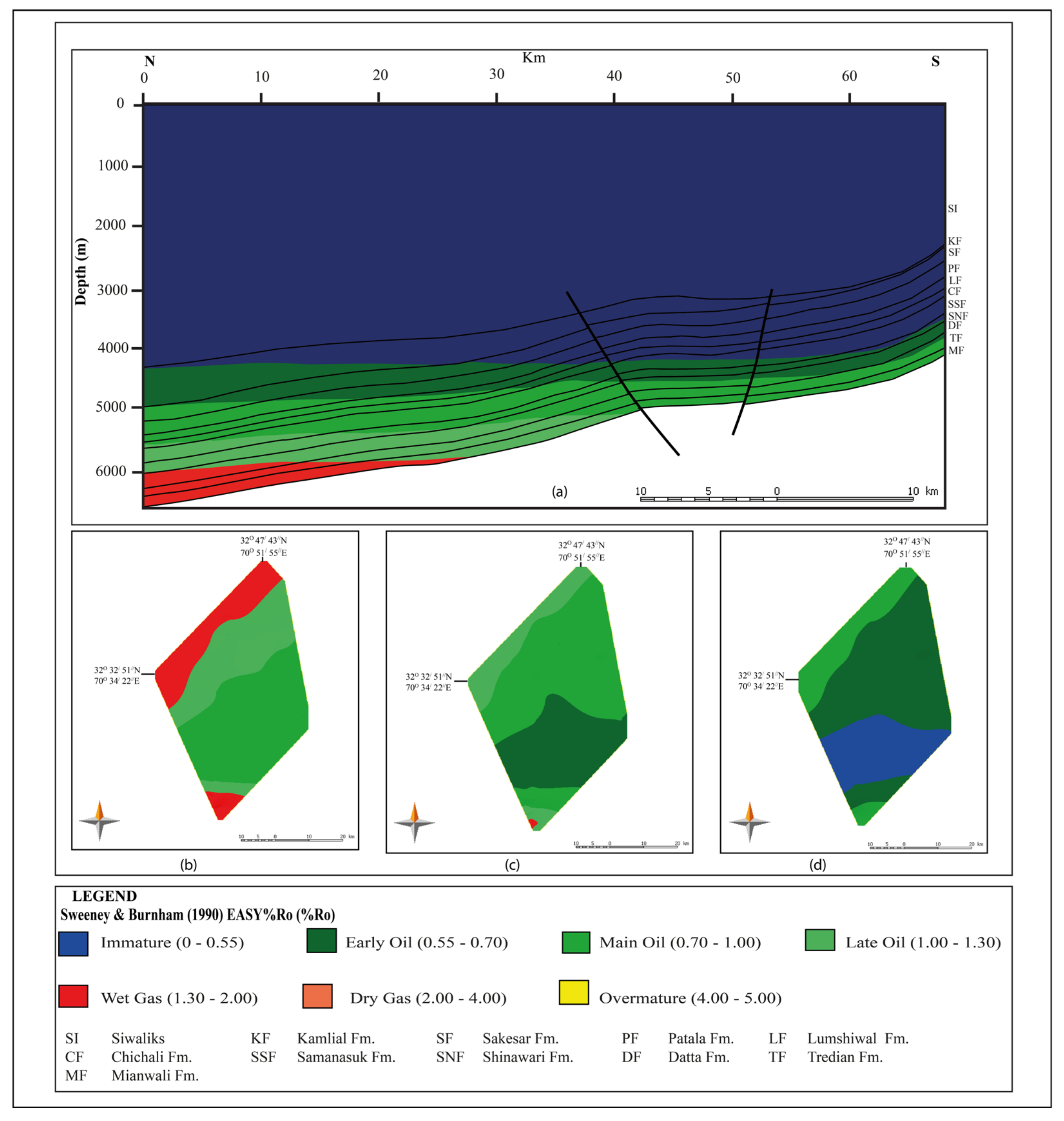

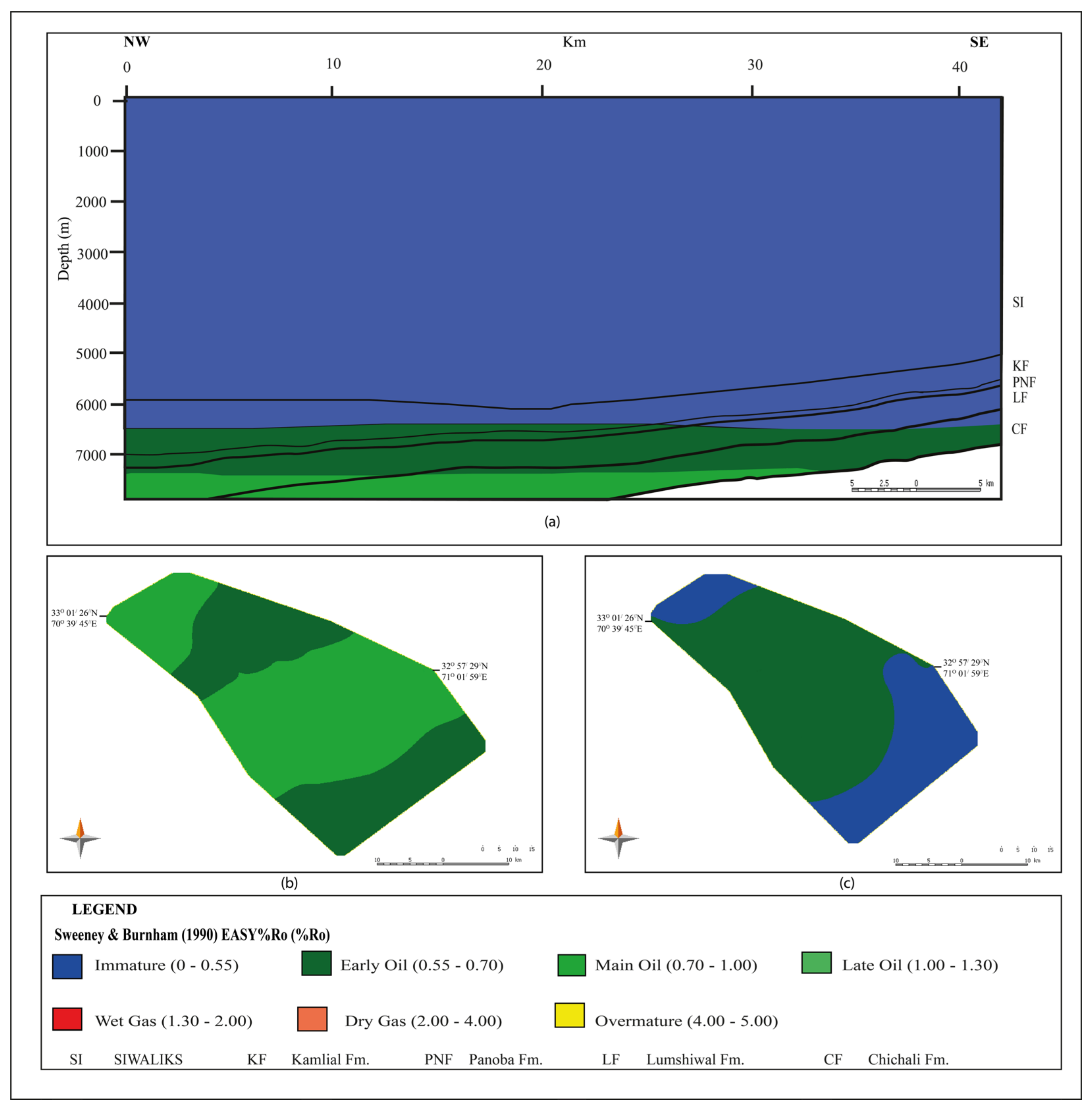
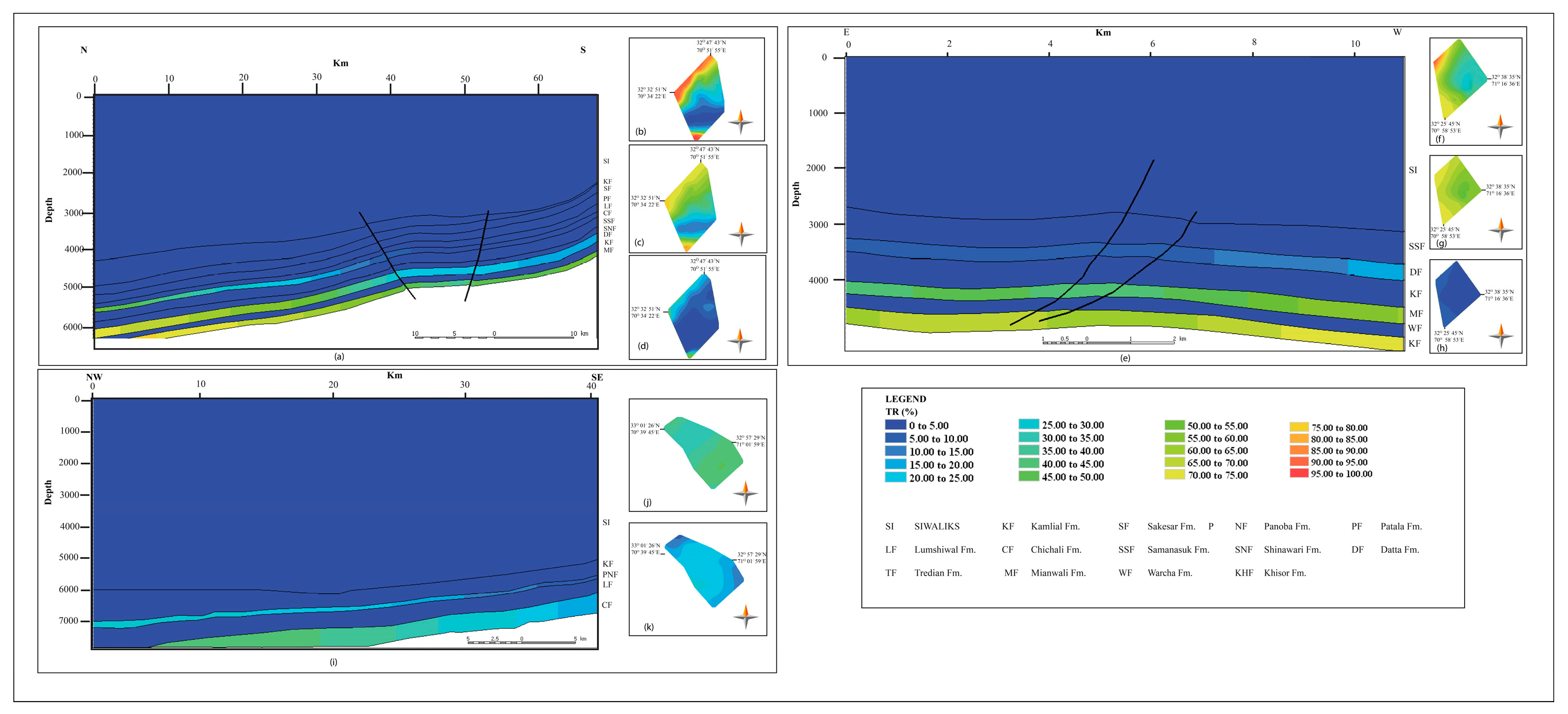

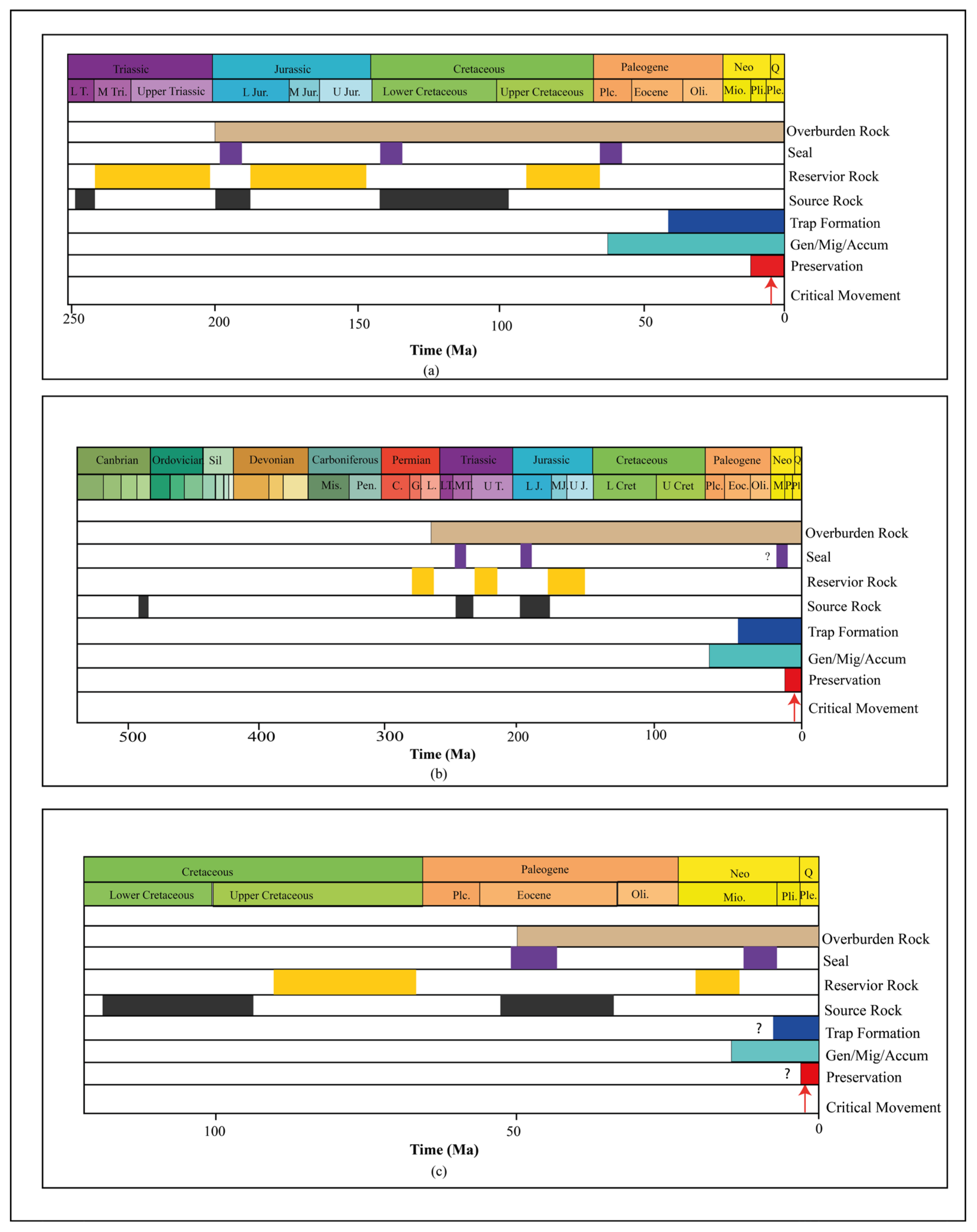
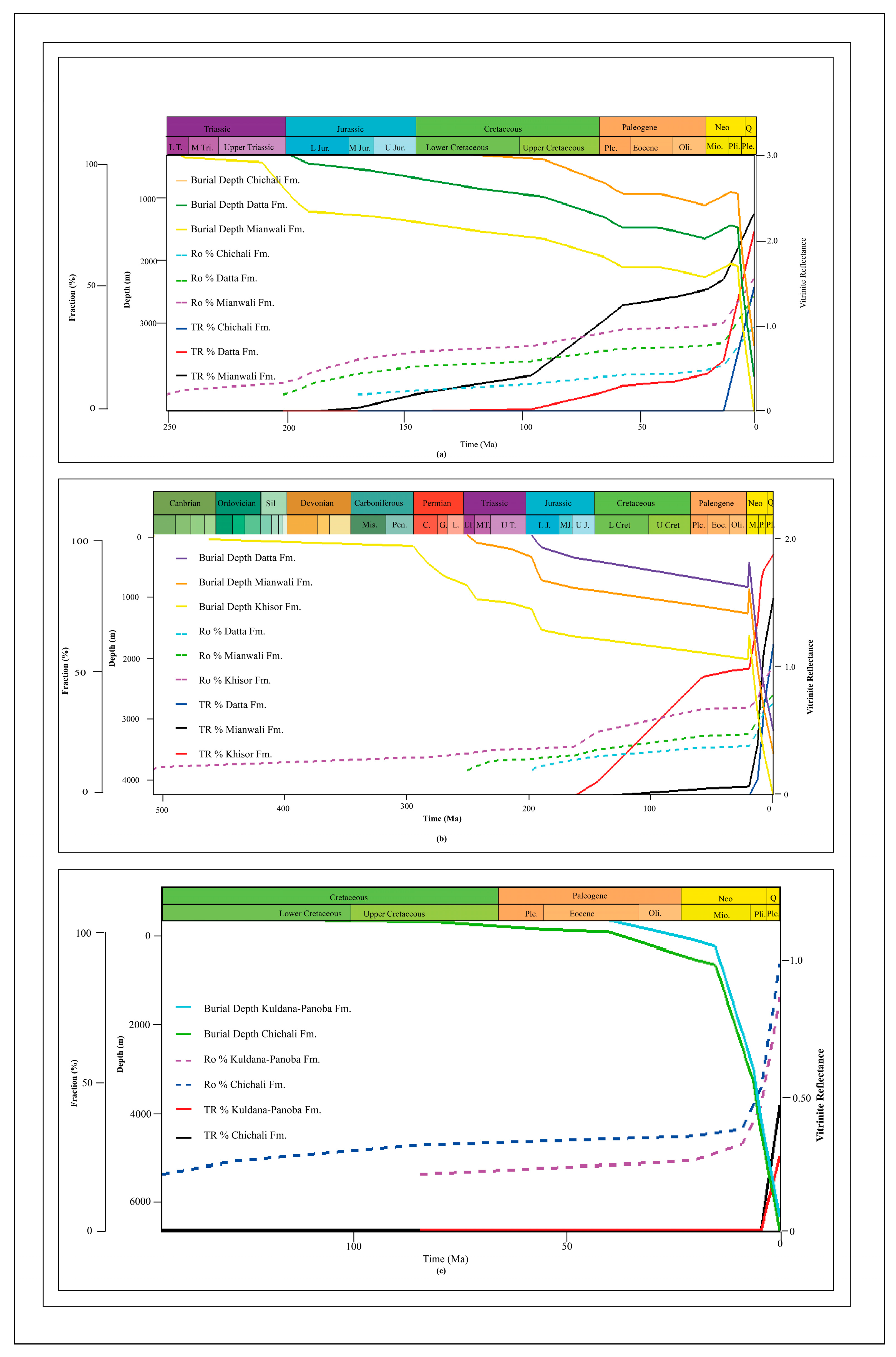
| Zones | Formations | Lithology (%) | Initial Por. (%) | Density (kg m−3) | Perm. at Porosity of (log mD *) | Heat Capacity (Kcal Kg−1 K−1) | Thermal Conductivity (W m−1 K−1) | |||||
|---|---|---|---|---|---|---|---|---|---|---|---|---|
| Lm. * | Ss. * | Sh. * | 25% | 45% | 20 °C | 100 °C | 20 °C | 100 °C | ||||
| Southwestern Zone | Siwaliks | - | 38 | 62 | 58.9 | 2707.6 | −0.7 | 0.8 | 0.20 | 0.24 | 2.2 | 2.1 |
| Kamlial Fm | - | 42 | 58 | 57.4 | 2725.2 | −0.9 | 0.6 | 0.21 | 0.24 | 2.2 | 2.1 | |
| Sakesar Fm | 90 | - | 10 | 38.5 | 2736.0 | 2.2 | 2.4 | 0.20 | 0.23 | 2.8 | 2.5 | |
| Patala Fm | −1.3 | |||||||||||
| Lumshiwal Fm | - | 92 | 8 | 44.2 | 2700.0 | 2.5 | 4.4 | 0.20 | 0.23 | 5.3 | 4.4 | |
| Chichali Fm | - | 5 | 95 | 68.5 | 2617.5 | −2.7 | −1.0 | 0.21 | 0.24 | 1.5 | 1.6 | |
| Samanasuk Fm | 95 | - | 5 | 36.6 | 2738.0 | 2.5 | 2.8 | 0.20 | 0.23 | 2.9 | 2.6 | |
| Shinawari Fm | 80 | 15 | 5 | 40.5 | 2720.0 | 1.9 | 2.4 | 0.20 | 0.23 | 2.6 | 2.4 | |
| Datta Fm | - | 40 | 60 | 58.8 | 2646.0 | −0.6 | 1.1 | 0.20 | 0.24 | 2.5 | 2.3 | |
| Tredian Fm | - | 85 | 15 | 46.2 | 2700.0 | 2.1 | 3.8 | 0.20 | 0.23 | 4.9 | 4.0 | |
| Mianwali Fm | - | 35 | 65 | 59.5 | 2662.5 | −1.2 | 0.3 | 0.21 | 0.24 | 1.9 | 1.9 | |
| Southeastern Zone | Siwaliks | - | 48 | 52 | 56.0 | 2709.6 | −0.1 | 1.3 | 0.20 | 0.24 | 2.5 | 2.3 |
| Samanasuk Fm | 93 | - | 7 | 37.2 | 2737.2 | 2.4 | 2.8 | 0.20 | 0.23 | 2.8 | 2.6 | |
| Datta Fm | - | 42 | 58 | 58.2 | 2647.8 | −0.4 | 1.2 | 0.20 | 0.24 | 2.6 | 2.4 | |
| Tredian Fm | - | 89 | 11 | 45.0 | 2700.0 | 2.3 | 3.8 | 0.20 | 0.23 | 5.1 | 4.2 | |
| Mianwali Fm | - | 37 | 63 | 58.9 | 2665.5 | −1.1 | 0.4 | 0.21 | 0.24 | 1.9 | 1.9 | |
| Warcha Fm | - | 90 | 10 | 44.8 | 2700.0 | 2.4 | 4.1 | 0.20 | 0.23 | 5.2 | 4.3 | |
| Khisor Fm | - | 18 | 82 | 64.6 | 2637.0 | −2.1 | −0.3 | 0.21 | 0.24 | 1.6 | 1.7 | |
| Northeastern Zone | Siwaliks | - | 51 | 49 | 55.2 | 2710.20 | 0.0 | 1.4 | 0.20 | 0.24 | 2.5 | 2.3 |
| Kamlial Fm | - | 45 | 55 | 56.5 | 2727.0 | −0.7 | 0.9 | 0.21 | 0.24 | 2.2 | 2.1 | |
| Kuldana/Panoba Fm | 10 | - | 90 | 53 | 2623.0 | −2.4 | −1.0 | 0.21 | 0.24 | 1.5 | 1.6 | |
| Lumshiwal Fm | - | 87 | 13 | 45.6 | 2700.0 | 2.2 | 4.0 | 0.20 | 0.23 | 5.0 | 4.1 | |
| Chichali Fm | - | 8 | 92 | 67.6 | 2622.0 | −2.6 | −1.0 | 0.21 | 0.24 | 1.5 | 1.6 | |
| Zones | Age | Source Rock | TOC (%) | HI (mg HC/g TOC) | VR | Kerogen Type | Capillary Pressure Petroleum-Water (MPa) | ||
|---|---|---|---|---|---|---|---|---|---|
| 60% por. (Khisor Fm, Mianwali Fm) 53% por. (Datta Fm, Chichali Fm, Panoba Fm) | 25% por. | 5% por. | |||||||
| Southwestern Zone | Triassic | Mianwali Fm | 0.50 | 380 | 0.93 | Type II/III | 0 | 0.14 | 1.2 |
| Jurassic | Datta Fm | 2.65 | 130 | 0.8 | 0 | 0.12 | 1.01 | ||
| Cretaceous | Chichali Fm | 1.24 | 247 | 0.6 | 0 | 0.25 | 1.63 | ||
| Southeastern Zone | Permian | Khisor Fm | 0.90 | 210 | 0.7 | 0 | 0.22 | 1.41 | |
| Triassic | Mianwali Fm | 1.68 | 254 | 0.64 | 0 | 0.14 | 1.04 | ||
| Jurassic | Datta Fm | 0.67 | 140 | 0 | 0.13 | 0.90 | |||
| Northeastern Zone | Cretaceous | Chichali Fm | 1.10 | 180 | 0.62 | 0 | 0.25 | 1.55 | |
| Paleocene | Panoba Fm | 0.61 | 98 | 0.51 | 0 | 0.22 | 1.53 | ||
Disclaimer/Publisher’s Note: The statements, opinions and data contained in all publications are solely those of the individual author(s) and contributor(s) and not of MDPI and/or the editor(s). MDPI and/or the editor(s) disclaim responsibility for any injury to people or property resulting from any ideas, methods, instructions or products referred to in the content. |
© 2023 by the authors. Licensee MDPI, Basel, Switzerland. This article is an open access article distributed under the terms and conditions of the Creative Commons Attribution (CC BY) license (https://creativecommons.org/licenses/by/4.0/).
Share and Cite
Mir, A.; Khan, M.R.; Wahid, A.; Iqbal, M.A.; Rezaee, R.; Ali, S.H.; Erdal, Y.D. Petroleum System Modeling of a Fold and Thrust Belt: A Case Study from the Bannu Basin, Pakistan. Energies 2023, 16, 4710. https://doi.org/10.3390/en16124710
Mir A, Khan MR, Wahid A, Iqbal MA, Rezaee R, Ali SH, Erdal YD. Petroleum System Modeling of a Fold and Thrust Belt: A Case Study from the Bannu Basin, Pakistan. Energies. 2023; 16(12):4710. https://doi.org/10.3390/en16124710
Chicago/Turabian StyleMir, Afzal, Muhammad Rustam Khan, Ali Wahid, Muhammad Atif Iqbal, Reza Rezaee, Syed Haroon Ali, and Yucel Deniz Erdal. 2023. "Petroleum System Modeling of a Fold and Thrust Belt: A Case Study from the Bannu Basin, Pakistan" Energies 16, no. 12: 4710. https://doi.org/10.3390/en16124710





